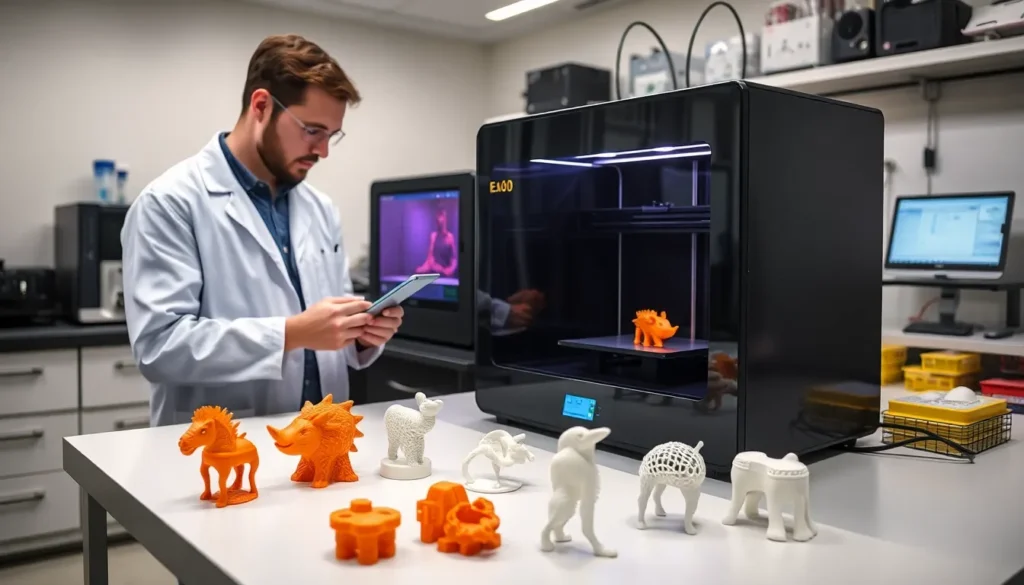In the fast-paced world of IT, automation isn’t just a buzzword; it’s the superhero cape that transforms mundane tasks into streamlined efficiency. Picture this: while your coffee brews, software robots are busy tackling repetitive chores, leaving IT professionals free to focus on the fun stuff—like solving the universe’s greatest mysteries or, you know, optimizing systems.
Table of Contents
ToggleOverview of Automation Trends in IT
Automation in IT continually evolves, driven by technological advancements and business needs. Businesses increasingly adopt robotic process automation (RPA) to streamline operations, reduce errors, and enhance data management. Practitioners frequently implement AI-driven solutions, which allow for smarter decision-making and real-time data analysis.
Cloud computing shapes automation trends by providing scalable environments where automation tools can thrive. Organizations leverage cloud-based platforms to facilitate integration and improve collaborative workflows. These platforms support various automation strategies, including infrastructure as code (IaC) that automates server provisioning and configurations.
Continuous integration and continuous deployment (CI/CD) practices gain traction among development teams, enabling them to deliver software updates more efficiently. They utilize automation tools to test and deploy code changes, minimizing manual interventions and accelerating release cycles. Developers typically benefit from these practices as it enhances feedback loops and promotes innovation.
Security automation also emerges as a priority in IT, especially with the rise of cyber threats. Professionals integrate automated security measures, including threat detection and incident response, to respond rapidly to vulnerabilities. This proactive approach mitigates risk and strengthens overall security postures.
Finally, DevOps practices exemplify the increasing focus on collaboration and automation. Teams use automation to streamline workflows, enhancing communication and productivity. Collaborative tools emerge as critical components that drive successful automation initiatives across organizations.
Key Technologies Driving Automation
Automation in IT relies on several key technologies, enhancing efficiency and driving productivity. Key advancements include artificial intelligence, machine learning, and robotic process automation.
Artificial Intelligence and Machine Learning
Artificial intelligence (AI) transforms decision-making processes across organizations. Machine learning applications predict trends and automate complex tasks, allowing teams to focus on strategic initiatives. Real-time data analysis powered by AI leads to insightful recommendations, improving overall operations. According to Gartner, by 2025, 75% of enterprises will lever AI tools for improved decision-making. Additionally, these technologies enable more intuitive user experiences, significantly enhancing customer interactions.
Robotic Process Automation
Robotic process automation (RPA) automates repetitive tasks, significantly boosting productivity. Businesses implement RPA to streamline processes like data entry and invoice processing. In fact, RPA can reduce operational costs by up to 30%. By minimizing human error, RPA enhances accuracy and efficiency in routine operations. Organizations that adopt RPA often notice quicker turnaround times and improved service delivery. Leading companies increasingly rely on RPA tools, highlighting its crucial role in digital transformation strategies.
Benefits of Implementing Automation
Implementing automation brings numerous benefits to the IT sector. Enhanced productivity and efficiency are key advantages, along with significant cost savings.
Increased Efficiency
Increased efficiency stands out as a primary benefit. Automation processes repetitive tasks, allowing employees to focus on innovative projects. Streamlined workflows lead to faster task completion. Employees experience less burnout, contributing to a positive work environment. Organizations often notice reduced errors due to consistent automation measures. Performance analytics reveal that IT teams can accomplish up to 40% more work when utilizing automation tools.
Cost Reduction
Cost reduction becomes evident through automated operations. Companies that adopt RPA can cut operational costs by as much as 30%. Reducing manual labor leads to savings in workforce management expenses. Automation also minimizes the risk of costly errors, further improving the bottom line. With fewer resources allocated to mundane tasks, organizations can invest in strategic initiatives. Overall, automation promotes a lean and efficient operational model, ensuring better financial health.
Challenges in Adopting Automation
Adopting automation in IT brings significant challenges. Organizations face various obstacles that affect implementation and effectiveness.
Security Concerns
Security issues pose a major challenge when implementing automation. Cyber threats increase as reliance on automated systems grows. Data breaches and vulnerabilities can become more frequent without proper safeguards. Companies must invest in robust security measures to protect sensitive information and ensure compliance. Automating security processes is essential, yet organizations cannot overlook the need for continuous monitoring and updates. With automated systems, the risk of exploitation heightens, emphasizing the need for a proactive security strategy.
Resistance to Change
Resistance to change often hinders automation efforts in IT. Employees may fear job displacement or lack confidence in new technologies. This apprehension can lead to pushback, negatively impacting the adoption process. Effective communication about the advantages of automation can alleviate concerns, highlighting how it enhances and simplifies tasks rather than replaces jobs. Training programs play a crucial role, offering employees the skills needed to adapt. Cultivating a culture that embraces innovation encourages acceptance of automation, facilitating smoother transitions and increased organizational buy-in.
Future Predictions for Automation Trends in IT
Automation in IT is evolving rapidly, with significant predictions shaping the future. By 2025, 75% of enterprises will utilize AI tools for improved decision-making processes. Growth in AI capabilities is set to enhance predictive analysis, driving business insights that facilitate quicker responses to market changes.
Robotic process automation (RPA) continues to gain traction, with organizations expected to increase adoption rates significantly. This surge aims at reducing operational costs by up to 30% through the automation of mundane tasks, leading to enhanced employee productivity. Increased efficiency allows IT professionals to commit to innovative projects that contribute to digital transformation goals, further propelling organizational success.
Cloud computing’s impact on automation trends remains substantial. Flexible and scalable environments provided by cloud solutions foster the application of automation tools. Companies are more inclined to implement infrastructure as code (IaC) strategies, streamlining the management of their IT environments.
Security automation is emerging as a priority in response to heightened cyber threats. Organizations will likely focus on automated threat detection systems and incident response actions, bolstering their defenses against cyber intrusions. Addressing security as a fundamental component of automation strategy will become crucial for safeguarding sensitive data.
Ultimately, continuous integration and continuous deployment (CI/CD) practices will further influence automation strategies. Aided by automated workflows, development teams will deliver software updates swiftly and efficiently, significantly enhancing overall productivity. Overall, the continuous trend towards embracing automation reflects the growing need for increased efficiency, security, and adaptability in the ever-evolving IT landscape.
Conclusion
The future of automation in IT is bright and full of potential. As organizations increasingly adopt AI and RPA technologies, they’ll unlock new levels of efficiency and innovation. The shift towards cloud computing and robust CI/CD practices will further streamline operations and enhance software delivery.
With the growing emphasis on security automation, businesses will be better equipped to combat cyber threats while maintaining compliance. Embracing these trends not only fosters collaboration among teams but also positions organizations to thrive in an ever-evolving digital landscape. As automation continues to reshape the IT industry, staying ahead of these trends will be crucial for success.














